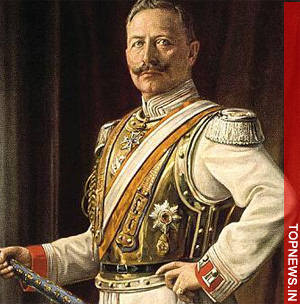Emperor's last resting place: Castle Doorn in the Netherlands
 Utrecht, Netherlands - The final years of Germany's last emperor, Kaiser Wilhelm II, were spent in Castle Dorn in the Netherlands.
Utrecht, Netherlands - The final years of Germany's last emperor, Kaiser Wilhelm II, were spent in Castle Dorn in the Netherlands.
The castle is a testament to its royal resident as the house is set in a spacious garden. A bridge leads over a water lily-filled moat to a flight of stairs leading to the castle's main entrance.
The interior also reflects Wilhelm's aristocratic heritage and is filled with only the finest furniture.
Wilhelm II spent his last 20 years in Castle Doorn after his abdication as German monarch in 1918. Today, Doorn is a museum dedicated to Germany's last emperor.
The 150th anniversary of Wilhelm's birth falls on January 27. But hardly anyone in Germany is aware that Wilhelm spent over a quarter of his life in Doorn. He bought the castle in 1919 for 500,000 guilders and installed heating, new bathrooms, new flooring and fireplaces.
The castle's lighting was modernized, the telephone upgraded and the gardens given their own lighting. Wilhelm's life in exile was evidently made easier by his generous budget.
To this day, Castle Doorn still has a comfortable and yet impressive appearance. Visitors pass through a large gate that Wilhelm had built in the Dutch Renaissance style with towers, stairways as well as wooden-framed and transom windows.
Beside the path that leads to the castle is a marble bust of the former emperor with his characteristic upturned moustache.
The only way to see the interior of the house where Wilhelm died in 1941 is as part of a guided tour.
The rooms have hardly changed since Wilhelm's time at the castle: paintings, carpets, furniture as well as cups and plates from the Royal Prussian Porcelain Manufacture originally came from Berlin's Royal Palace, Bellevue Palace and the New Palace in Potsdam.
At the time of Wilhelm's abdication, 59 train carriages of furniture and other objects were transported to Doorn.
Even the castle's entrance has plenty to interest the visitor, with portraits of Frederick William, the Great Elector, and his Dutch wife Luise Henriette.
The largest room in the house is the dining room. Upon the dining table stand plates, glasses, carafes, salt cellars and two Rococo candelabras. Each place setting has its own silver cutlery ready-in- waiting for any guest.
Goblets, Meissen porcelain and marble are to be found in some of the castle's other rooms. The smoking room contains a valuable collection of snuff boxes that were once owned by Frederick the Great, whom Wilhelm admired.
The castle also provides visitors with an insight into Wilhelm's private life, such as his library and study where he read the daily newspapers and opened his post. His bedroom and bathroom with a blue and gold toilet hidden in a closet are also open to visitors.
The castle's kitchen was housed in the cellar. It still contains plates, cups and pots from Wilhelm's era. The shelves heave with glass jars containing preserves and the kitchen oven looks as if it is ready to be fired up.
Everything appears as if the emperor could return at any time, although he died more than six decades ago and is buried in a mausoleum in the castle garden.
Internet: www. huisdoorn. nl. (dpa)